
Christmas Steps (1)
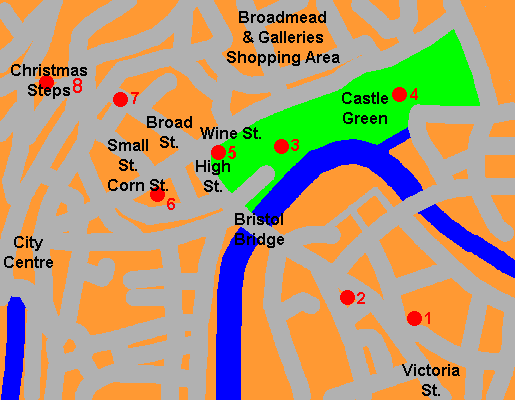
From Victoria Street to Christmas Steps.
Over the main road from St John's Gate is Christmas Steps. This is another old part of Bristol, with several building a couple of hundred years old. The fish and chip shop at the bottom is around 300 years old. At the bottom of Christmas Steps is the remains of St. Bartholomew's Hospital.
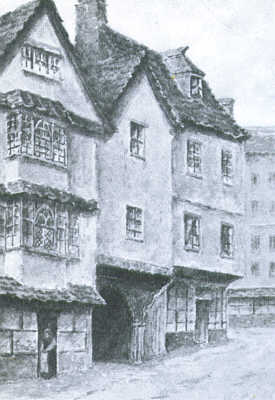
St. Bartholomew's Hospital
image from Unknown Bristol by Rosemary Clinch (Bossiney Books, 1985)
It's unknown exactly when the hospital was founded but it was certainly after 1231. The land was given to it by Sir John la Warre and the first mention of it appears in a deed dated before 1243 saying that Brother Geoffrey was Master of St. Bartholomew's. The Master of St. Bartholomew's seems to have been elected by the la Warre's from local priests. The rough and tumble life in Bristol at the time can be seen in the fact that in 1285 the Master was killed by two chaplains from St. James's Priory and that Sir John de Merschton or Merston, Master in the early 14th century, was threatened with excommunication for failing to fulfill his office.
Very little is known about the staff or inmates of the time except that the hospital acted more like a almshouse which also catered to visitors to the city. It is also known from 14th century documents that there were separate dormitories for men and women and the hospital had its own burial ground. In the 1330's Eleanor the new Prioress seems to have evicted the males from the hospital. It is uncertain whether this meant the inmates or perhaps more probably, just the male staff.
In 1386, the Bishop of Worcester reintroduced men into the hospital and the right of the la Warre's to appoint the Masters was re-established. The women tried to reassert their claim in 1412, but this was rejected by a jury convened by Bishop Peverell. An interesting claim was made during these proceedings in that a valuation of the property couldn't be ascertained due to its dilapidated condition, something that seems common throughout the building's life.
In 1445, provision for 12 poor mariners with their own Priest was established at the hospital. These were known as the Fraternity of St. Clement and their keep was paid for by a levy on the ships entering the Port of Bristol. The hospital carried on its charitable work up until the 1530's and the dissolution of the religious houses when it began to be used for other purposes.
Masters of St. Bartholomew's Hospital
Walter, 1319
John de Hulle, 1322 resigned in 1329
Robert de Merston, 1329
John de Merston, 1331
Prioresses
Eleanor, 1340
Elizabeth Batte, became prioress in 1363
Joanna Joye, 1368
Matilda Coveley, 1369
Masters
William Badesford, 1386 resigned in 1389
John Dauntre, 1389 exchanged in 1403
John Prentys, resigned 1412
John Arundel, 1412
John White, 1457 resigned in 1463
William Attingham, 1463
Thomas Mark, resigned 1480
John Langrissh, 1480
James Butler, 1488
Humphrey Saville, 1511
George Croft, circa 1524-31
On 31st January 1532 a Bristol merchant, Robert Thorne, who was MP for Bristol in 1523, and Lord la Warre came to an agreement where Thorne would take over control of the building. His plan was to start a school there but provision was made to keep the poor already there until they died, they were to get 4d or 5d., depending on which account you read, a day each.
However, there now started a legal wrangle over the site which would eventually involve several generations of the Thorne family and which was only finally settled in 1617. The contract between la Warre and Thorne was illegal, but on March 17th King Henry VIII granted the Mayor and corporation a petition to take control of the hospital in trust for Robert Thorne. On May 17th Thorne wrote in his will that £300 should go to the hospital. He died that summer and the hospital passed in the hands of his brother, Nicholas. Nicholas was Mayor of Bristol in 1544/45.
There's some disagreement as to whether the school to be established was new or a moving of the one that was housed in a room over the Frome Gate. Whichever it was, Bristol Grammar School started life in the old hospital buildings sometime between 1536 and 1540. The lapse of at least four years before the start of the school isn't explained but was probably to do with wrangling with the city corporation. The building was by now in a bad state of repair and had been for some time. Leland, in the 1520's, wrote that the buildings were in ruinous state.
The hospital chapel seems to have been in use at least up to the late 16th century as in 1546, Nicholas Thorne bequeathed money for improvements to the altars, glazing and vestments. The building was much altered during the following century but in 1767 conditions were still unsatisfactory for the school and it moved to a site on College Green. This new site was once the home of St. Mark's Hospital but had been home to the Queen Elizabeth's Hospital School since its foundation by John Carr in 1586. In fact, the move was more of a swap as Queen Elizabeth's Hospital School move to the old buildings that had housed the Bristol Grammar School.
St. Mark's Hospital, later Bristol Grammar School, is now the Lord Mayor's Chapel on College Green.
Life in schools at the time was pretty hard here's the diet for pupils of Queen Elizabeth's Hospital School in 1790...
Breakfast every morning: Bread and butter
Dinner:
Sunday: Boiled beef, potatoes and and bread
Monday : Milk pottage or water gruel with bread and butter
Tuesday: Mutton, potatoes and bread
Wednesday: Pork and peas, bread and butter
Thursday: Boiled beef, potatoes and and bread
Friday: Boiled mutton and broth
Saturday: Milk pottage with bread and butter
Supper every evening: Bread and cheese
Small beer was served with every meal.
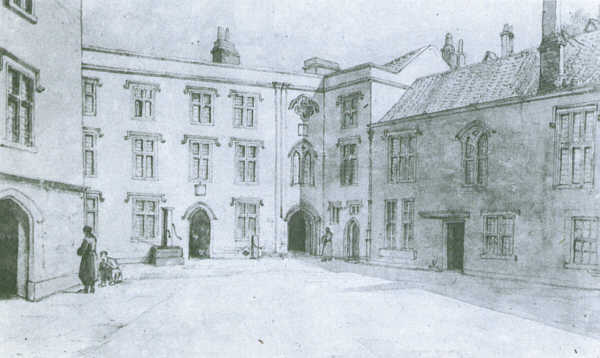
The Courtyard of Queen Elizabeth's Hospital School in 1820
image from Excavations at St. Bartholomew's Hospital, Bristol (Redcliffe Press / Bristol Threatened History Society, 1979)
Despite some improvements, the buildings they were soon falling into disrepair again and in 1847, Queen Elizabeth's Hospital School moved into the buildings it still occupies on Brandon Hill.
Since its foundation around 1240 to 1847, the building had only three occupiers...
St. Bartholomew's Hospital - to around 1538
Bristol Grammar School - to 1767
Queen Elizabeth's Hospital School - to 1847
By 1847, the original buildings had been altered many times and this was to continue as the building entered a new, more industrial phase of its occupancy. After Queen Elizabeth's Hospital School had left it was taken over by a cooper. The entire area around the buildings had declined and those living around it were some of the poorest in Bristol. In 1856, Bristol Municipal Charities, who were the Trustees then took over the site and remodelled it to be a "model dwellings for the industrial classes". The scheme didn't last long and by 1881 the buildings were occupied by a boot-maker. Until 1900, the building had a variety of uses when it was used by the printers, Burleigh Press. Burleigh Press undertook all sorts of printing work but also printed several books about Bristol, among them "Bristol Worthies" by A. B. Freeman in 1909 and "Bristol, England" by H. G. Brown and P. J. Harris in 1946. Burleigh Press occupied the site until 1976.
With the building now empty after over 700 years of continuous use the next two years were spent doing extensive archaeological excavations. Not much is left of the original buildings but the main archway is still there but much of the site is now private offices.
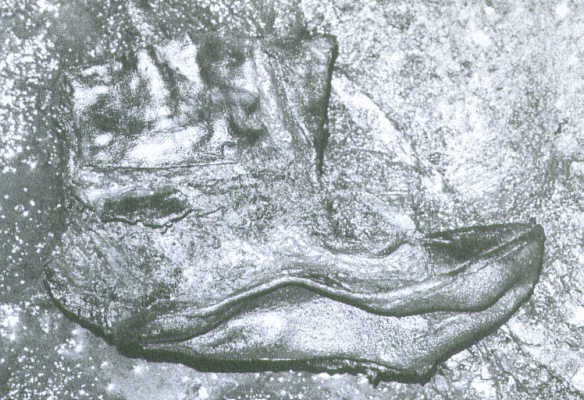
A 13th Century leather shoe recovered during the excavations of St. Bartholomew's Hospital
image from Excavations at St. Bartholomew's Hospital, Bristol (Redcliffe Press / Bristol Threatened History Society, 1979)

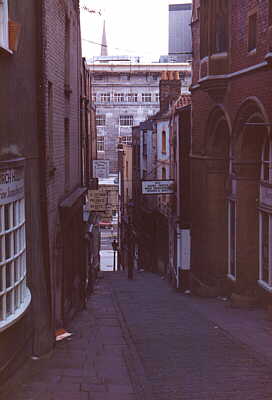
Christmas Steps from the bottom and top (March 2000)
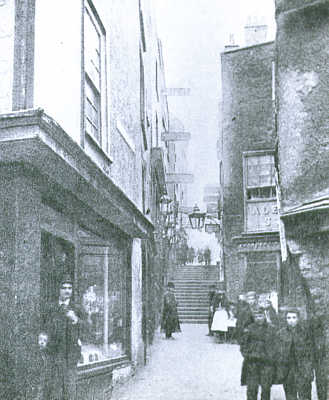
Christmas Steps around 1890
image from Bristol as it Was 1845 - 1900 by Reece Winstone (Reece Winstone, 1983)(plate 93)
The Steps contain many specialist shops and art galleries. Christmas Steps was renamed Queen Street and rebuilt in 1669, a plaque commemorates the event.
Rebuilt AD 1881
This Streete was steppered done
& finished September 1669.
The Right Worpfl Thomas Stevens
Esqr then Mayor, Humphry Little
and Richard Hart, Sherrifffes, the
Right Worpfl Robert Yeamans
Knt & Barronet, Mayor Elect, Charles
Powell and Edward Horne Sherriffes
Elect of this Citty.
By and at the cost of Jonathan
Blackwell, Esqr Formerly Sherriffe
of this Citty and afterwards
Alderman of the Citty of London
& by ye said Sir Robert Yeamans then
Mayor and Alderman of this Citty
named Queene Streete.
The Yeamans family has a long association with Bristol. Jonathon Blackwell who paid for the street, then known as Queene Streete, to be paved and "steppered" in 1669 was a wealthy vintner. He also had a turnstile and lamp lighting installed. The street probably needed them as before then it was described by John Latimer in "Annals of Bristol in the Seventeenth Century" as a "break-neck footpath very perilous to passengers in winter weather and dark nights."
A calendar describes the alterations made by Blackwell, "Going up, there is steps, on the last of which is a turned style or whirligig, over which there is a lantern; then about 100 feet pitched; and then steps, with a court with six seats on each side; and then steps and a turnstyle like the former."
The seats caused a bit of a problem for historians. In their "Bristol Past and Present" (J. W. Arrowsmith, 1881) J. F. Nicholls & J. Taylor say that the seats were "sedilia" or begging places for the friars from the Chapel of the Three Kings of Cologne which stands at the top of the Christmas Steps but this appears to be unlikely because the Chapel is much older than the remodelling.
It was renamed Queene Streete in celebration of Queen Catherine of Braganza who married King Charles II on 23rd April 1662. However the street has been known by a variety of names and nicknames over the centuries.
Christmas Street was an important Bristol thoroughfare that ran from St. John's Gate, Broad Quay over the River Frome, now covered by the city centre, to the Frome Gate near St. Bartholomew's, the remains of which are still at the bottom of Christmas Steps. It then became a steep lane that was to become Queene Streete and later Christmas Steps, and carried on up towards St. Michael's Hill.
In the Middle-Ages most trades were carried out in specific areas or streets and Christmas Steps was home to the cutlers - makers of blade-edged steel weapons and tools and armourers. Around this time, 1389 to be specific, it was called by both Knyfsmythestrete and Cutellare Street. The 1385 will of Robert Gradely refers to Knyzt-mass Street. Another will, dated 1390, refers to a smith, John Donster, living in Christmastrete and for several hundred years all these names appear to have been used for the road. Various other names appear on old city ordnances such as Christsmith and Cutlermass. By 1500 though it seems that Christmas Street had become the most popular.
During the English Civil War (1625 - 1649) in July 1643, Christmas Steps was the scene of fierce fighting and Colonel Sir Henry Lunsford, a royalist, was killed there. For a while the place was known as Lunsford's Stairs, so perhaps there were steps of a sort there before the remodelling of 1669. Henry Lunsford was the brother of Sir Thomas Lunsford who was deputy-governor of Bristol, 1644/5.
In 1669, it became Queen Street and in 1775, finally became Christmas Steps. The reason for this may be linked to the earlier names of Knyzt-mass, Christsmith and Cutlermass. The Eucharist processions would take place here and so Christmas may be a corruption of Knife and Mass.
Christmas steps contains an eclectic collection of wonderful little shops and has done for centuries. Here's a listing from Kelly's Directory of 1894...
No. 1: John Hooking - baker
No. 2: Percy Musgrove Lyddon - beer retailer
No. 3: Henry Woodland - greengrocer
No. 4: Mrs. Mary Chapel
No. 5: Alfred West - tinplate worker
No. 6: Thomas Lewis - newsagent
No. 7: Henry Pacey - dining rooms
No. 8: William Brook - coffee rooms
No. 9: John Wiltshire - beer retailer
No. 10: George Fear - watch maker
No. 11: Fredrick Tichbon - hairdresser
...and this is from the 1906 directory...
No. 1: Joseph Harry Lock - trade not known
No. 2: Mrs Ada Palmer - Landlady of the Whitehorse public house
No. 3: Henry Worsley - antique dealer
No. 4: Henry Jarvis - secondhand book dealer
No. 5: George Roberts - shell fish dealer
No. 6: Mrs. Georgina Brooks - confectioner
No. 7: John Jones & Co. - engravers
No. 8: Arthur Owen - dining rooms
No. 8: Edwin Hollister - sweet shop
No. 9: John King - furniture dealer
No. 10: Alfred Williams - watchmaker
This page created 15th March 2000, last modified 16th January 2006